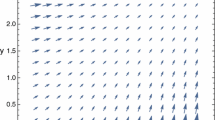Summary
The gravitational field predicted by general relativity for a tachyon is in many ways similar to the shock wave produced by an object moving faster than the signal velocity in a medium. It is an intense wave and for a dense macroscopic tachyon it is capable of exciting Weber’s gravitational radiation detection apparatus across astronomical distances.
Riassunto
Il campo gravitazionale previsto dalla teoria della relatività per un tachione è, per molti aspetti, simile all'onda d'urto prodotta da un oggetto in moto con velocità maggiore di quella della luce nel mezzo. L'onda è intensa e per un tachione macroscopico denso può eccitare l'apparato di rivelazione della radiazione gravitazionale costruito da Weber anche a distanze astronomiche.
Резюме
Предсказанное из общей теории относительности гравитационное поле для тахиона является во многих отношениях аналогичным ударной волне, рожденной обьектом, движущимся быстрее скорости света в среде. Эта волна представляет интенсивную волну и для плотного макроскопического тахиона эта волна способна через астрономические расстояния возбудить аппаратуру для детектирования гравитационного излучения Вебера.
Similar content being viewed by others
References
J. Weber:Phys. Rev. Lett.,17, 1228 (1966);22, 1320 (1969);24, 276 (1970).
G. Feinberg (Phys. Rev.,159, 1089 (1967)) appealed to general relativity to counter objections that tachyons subvert the usual arguments leading to Einstein's definition of simultaneity in special relativity.M. Sachs, E. C. G. Sudarshan andO. Bilaniuk have had an exchange inPhysics today (Vol.22, No. 12, 47, 50 (1969)) concerning the form of the tachyon energy-momentum tensor and we shall see below that the conclusion that this tensor is real was in fact correct.
R. Adler, M. Bazin andM. Schiffer:Introduction to General Relativity (New York, 1965).
The tachyon “Schwarzschild” field has been studied byA. Peres:Phys. Lett.,31 A, 361 (1970), who also found a kind of shock wave. This work is independent of that described in the present article, which was performed prior to the publication of Peres' paper.
Y. Choquet-Bruhat:Ann. Inst. Henri Poincaré,8 A, 327 (1968);A. Komar:Phys. Rev.,137, B 462 (1965);A. Papapetrou andH. Tredar:Math. Nachr.,23, 371 (1962). These authors (and others) consider various kinds of discontinuities ing μνand establish matching conditions, etc., across characteristic surfaces. Necessarily they impose certain regularity conditions (C 0or square summable) which unfortunately preclude their use in the present case.
A. Sommerfeld:Proc. Amsterdam Academy,7, 346 (1904). Sommerfeld incidentally suggests a hyperboloid-shaped electron, like our “interior” solution density, based on a kinematic analogy with Lorentz' ellipsoidal electron (forv<c). Nevertheless, he dismisses this proposal at the same time, he offers it with the words “… in this case you can hardly speak of a “Heaviside hyperboloid””. One amusing item in this same paper is the use by Sommerfeld of a function,F(x), which he attributes to Kirchhoff, with the following properties:\(\int {F\left( x \right)dx = 1,} F\left( x \right) = 0 for x \ne 0\) forx∈0.
H. H., Hubbard:Phys. Today,21, No. 2, 31 (1968).
J. Weber:Phys. Rev.,117, 306 (1960).
Author information
Authors and Affiliations
Additional information
Supported in part by the National Science Foundation and the U.S. Army Research Office (Durham).
Address 1970–71: Physics Department, Technion-Israel Institute of Technology, Haifa.
Traduzione a cura della Redazione.
Переведено редакицей.
Rights and permissions
About this article
Cite this article
Schulman, L.S. Gravitational shock waves from tachyons. Nuov Cim B 2, 38–44 (1971). https://doi.org/10.1007/BF02722230
Received:
Published:
Issue Date:
DOI: https://doi.org/10.1007/BF02722230



